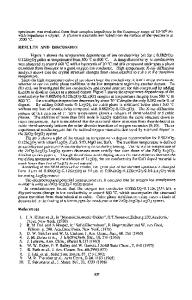Composition driven structural phase transitions in the (Y 1-x La x ) 2 Ti 2 O 7 system
- PDF / 565,770 Bytes
- 8 Pages / 612 x 792 pts (letter) Page_size
- 78 Downloads / 347 Views
Composition driven structural phase transitions in the (Y1-xLax)2Ti2O7 system Elizabeth J. Harvey, Sharon E. Ashbrook, Gregory R. Lumpkin, Simon A.T. Redfern Dept. of Earth Sciences, University of Cambridge, Downing Street, Cambridge, CB2 3EQ, UK ABSTRACT The structural characteristics of samples in the (Y1-xLax)2Ti2O7 system have been studied as a function of bulk composition using time-of-flight (TOF) powder neutron diffraction, powder X-ray diffraction (XRD), Electron Microscopy and 89Y (I = ½) Magic Angle Spinning Nuclear Magnetic Resonance (MAS NMR). Analysis of the neutron diffraction data suggests the following: For compositions where 0 ≤ x ≤ 0.132, a single cubic phase is present (Fd3,¯ m, Z = 8). Between 0.832 ≤ x ≤ 1, a solid solution with the La2Ti2O7 structure (P21, Z = 4) forms. The two phases coexist between x values of 0.132 and 0.832. XRD suggests that the limits of the two regions of solid solution fall within the ranges of x = 0.1-0.125 and x = 0.875-0.9. The variation in the limits found by the two diffraction methods may be due to stoichiometric errors in the samples. Line-shape analysis of NMR spectra for Y rich compositions suggests that increasing proportions of La are incorporated onto the pyrochlore A site in a statistically random manner, up to the limit of solid solution. The NMR spectra of the monoclinic phase suggest that occupation of the four crystallographically distinct ‘A’ type sites within the structure is not random. At low Y concentrations, two of these sites are preferentially occupied by Y. These sites are suggested to be those found at the edge of the perovskite slabs, which exhibit smaller coordination numbers (based on the number of oxygens within bonding distance of the ‘A’ type cation) than the true perovskite A sites found at the slab centres. INTRODUCTION In the evaluation of candidate waste forms for the immobilisation of high level nuclear waste (HLW), crystalline phase assemblages are often thought of as preferable to borosilicate glass based matrices, despite the higher projected costs of fabrication. Multiphase ceramics such as Synroc [1] have been shown to be far more resilient to intrinsic radiation damage and attack by groundwater than glass based waste forms; they do not devitrify over time and the composition of the immobilising medium can be optimised for a particular HLW stream so that the active species present are ‘locked’ into specific atomic positions within long lasting crystalline arrays. The pyrochlore structure (A2B2O7, Fd3,¯ m, Z = 8), is a particularly robust example of a candidate phase for immobilising HLW – natural samples containing U and Th have been found which are in excess of 1 Ga in age [2]. It is therefore considered to be an excellent crystalline species for the immobilisation of actinides, particularly Pu, where the long term (Ma) retention of radionuclides is paramount. In order to critically evaluate the suitability of such a phase, it is necessary to thoroughly understand its susceptibility to changes in composition – these affect its
Data Loading...











